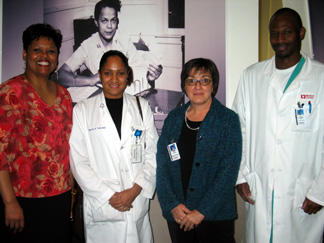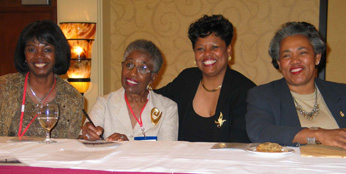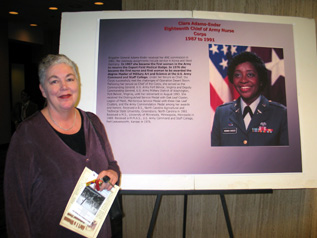 |
Valda Ford, left, with Sheritta Toler, M.D., first-year resident in UNMC/Creighton Department of Psychiatry; Lois Colburn, executive director of UNMC’s Center for Continuing Education; and Leon Robinson, third-year resident in the UNMC Department of Surgery. |
Valda Boyd Ford, director of UNMC Community and Multicultural Affairs, was keynote speaker at that event and shared the dais with Lt. Col. Loretta Hicks, M.D. (U.S.A.F. Ret.); Col. Sara Williams, Ph.D., (U.S.A.F. Ret.); and a certified giant in black female military history – 81-year old Maj. Nancy Leftenant Colon, (U.S.A. Ret.), the first African American woman to be commissioned a lieutenant in the Regular U.S. Army Nurse Corps in 1948.
Ford was invited to reprise her presentation for students, faculty and staff on campus by UNMC’s Center for Continuing Education and Community Partnership on Oct. 22 at the Eppley Science Hall Amphitheater. She provided a concise overview of the history of African American women in the field of nursing and put into perspective the long-term importance of African American breakthroughs while serving in the military during World War II.
Her encore presentation, titled, “Taking Flight with the Tuskegee Generation: An Historical Overview of African American Women in Nursing,” also provided an opportunity to display the series of historical posters that UNMC’s College of Nursing sponsored for the Tuskegee convention. Each 4- by 5-foot poster has extensive history about the individual women or units shown in the photographs. The posters will be permanently displayed in the College of Nursing.
Although Ford is not a military veteran, she was married to a U.S. Marine for years and started her nurse’s training at Camp Lejeune, N.C. But, like her military forbearers, she also found herself the only woman of color in many of her nursing educational and clinical experiences.
 |
Valda Ford, second right, at the 2004 Tuskegee Airmen Convention with from left, Col. Sara Williams, Ph.D., Major Nancy Leftenant Colon, and Lt. Col. Loretta Hicks, M.D. |
“Yet, African American women have been the primary nurses for black people since our very beginnings as slaves in this country. Not only were women the primary care givers in the slave quarters, but just as black men have served in every single war America ever fought, black women worked the military camps to provide support and health assistance for those black soldiers.”
Ford noted that during the Civil War, Harriet Tubman and Sojourner Truth – the greatest black female names of their era – both served as nurses to black Union troops. She read excerpts from Truth’s famous speech, “Ain’t I A Woman?” – a poignant response to the notion that women were supposed to be too soft and delicate to serve in masculine roles. Truth noted how she had long done the work of a man and possessed all the physical attributes of a female, yet, as a black woman and former slave, had never been accorded the respect and concern directed toward Caucasian women.
“Perhaps the hardest struggle for African American women has been full participation in the nation’s leading nursing associations,” Ford said. “Even though black women could train to be nurses, Jim Crow laws in 16 states kept them from belonging to the American Nurses Association (ANA).” In 1951, after many years of negotiation and promises by the ANA, black nurses disbanded the National Association of Colored Graduate Nurses and joined the ANA.
In 1879, Mary Eliza Mahoney was the first black woman in America to receive a nursing degree. The ANA eventually bestowed an annual award in her name in recognition of significant contributions to interracial relationships.
Frances Eliot Davis applied to the American Red Cross in 1915 for certification as a nurse, and had to keep fighting until 1917 before officially approved. But she still had to wear a pin that said, “A-1,” a virtual “Scarlet Letter” that identified her as a black person. Although, there were 1,800 black Red Cross nurses by 1939, none were allowed to serve overseas in the military until 1949.
 |
Barbara Head, assistant professor, UNMC College of Nursing – gerontology, in front of the poster of Brig. Gen. Clare Adams-Ender, Eighteenth Chief of U.S. Army Nurse Corps. |
Nursing has come a long way, “but none of these victories would have happened without the contributions of the nurses down through our history,” Ford said. “Their primary concern, especially during the segregated military era of World War II, was that the wounded and sick black soldiers would have people there to treat them and give them the best care. Remember, black soldiers fighting in World War II were not allowed to be treated by Caucasian nurses.”
No woman at the Tuskegee convention had the badge of legacy and heritage equal to Nancy Leftenant Colon, a world-traveled country girl, not only made indelible military history, but also is the first woman ever elected president of the Tuskegee Airmen International.
“I came from a family of six boys and six girls in Goose Grease, S.C.,” Major Colon said at the Tuskegee convention. “I was 12 years old before I found out that you were supposed to get presents at Christmas.”
Major Colon worked as a maid for an entire year to save up the $100 she needed to begin nursing school. As a nurse, her first salary was $20 a month. The school she attended was as much a “finishing school” as nursing school. She was taught how to dress and behave, as well as run an entire ward single-handedly. When she entered the military in 1944, she went from second lieutenant to first lieutenant in 11 months because no other nurses could carry the workload she had been trained to bear.
Major Colon was one of the first 36 black nurses ever sent as a group to the East Coast. Until that time, most black nurses were stationed out West, usually at Fort Huachuca, N.M.
“I think it is very important to remember that black women in the military suffered all the same segregation and indignities as the men did,” Major Colon said. “Traveling across the country was especially horrible for black women. Knowing I would have to drive great distances, I would not drink any fluids for up to two days before leaving — you just didn’t want to have to stop in the Southern towns to use a bathroom along the way in those days. That could just be too dangerous.”
Flight nurse was the most elite status for military nurses. Major Colon had to wait five years before certification as a flight nurse even though she had the highest ratings and scores. That is why she always counseled younger women that “you not only have to be excellent, you also have to be patient. Some doors just aren’t going to open right away and you have to have the perseverance to wait them out.”
As a flight nurse she served in Korea, Japan, Okinawa and Indochina. In an astonishing historic moment, Major Colon was aboard the first medical evacuation flight into the defeated French outpost in Dien Bien Phu, in Vietnam in 1954. Her life story will be an entire chapter in a book to be published about black women veterans of World War II written by history students at Hiram College, Hiram, Ohio.
“I am grateful that our university continues to provide forums to explore the history of health care and the role of people of color,” Ford said. “First, because I and others like me, stand on the shoulders of these ground breakers. Second, as we struggle with health disparities in the United States today, we must remember that a significant part of these disparities is due to the long-term effect of not having enough health care professionals of color that resulted from generations of discrimination and segregation.
“We don’t revisit this history for the purpose of recrimination and divisiveness. Rather, we use history as an aid to understanding how things got to be the way they are today and how we can work together to develop more inclusive health profession opportunities and patient outcomes in the future.”